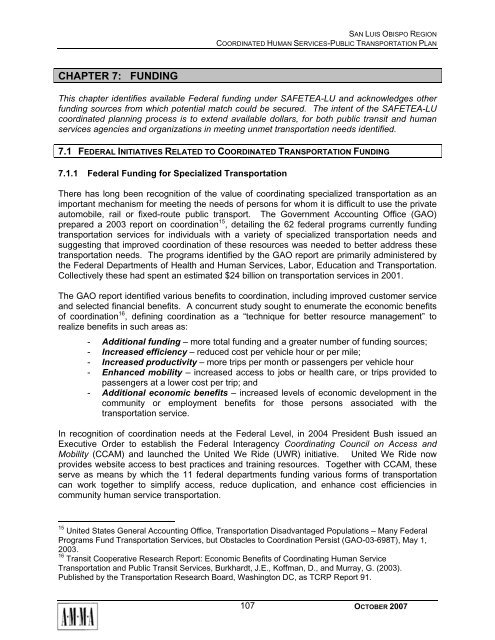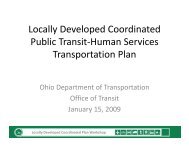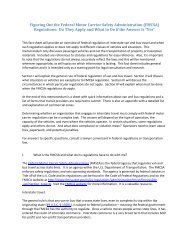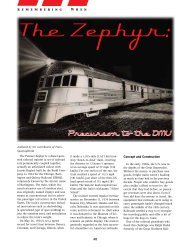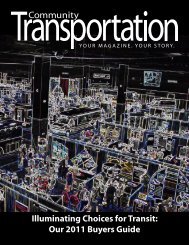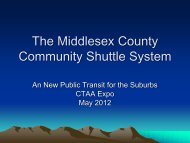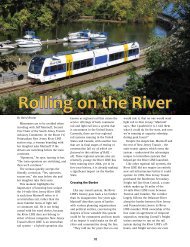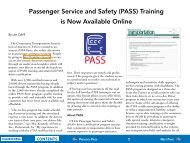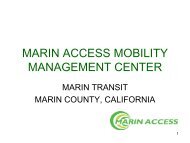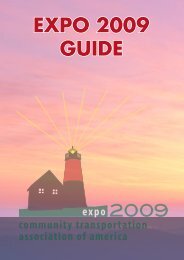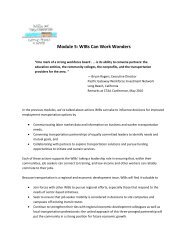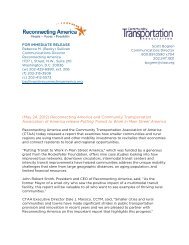San Luis Obispo - Caltrans - State of California
San Luis Obispo - Caltrans - State of California
San Luis Obispo - Caltrans - State of California
Create successful ePaper yourself
Turn your PDF publications into a flip-book with our unique Google optimized e-Paper software.
SAN LUIS OBISPO REGION<br />
COORDINATED HUMAN SERVICES-PUBLIC TRANSPORTATION PLAN<br />
CHAPTER 7: FUNDING<br />
This chapter identifies available Federal funding under SAFETEA-LU and acknowledges other<br />
funding sources from which potential match could be secured. The intent <strong>of</strong> the SAFETEA-LU<br />
coordinated planning process is to extend available dollars, for both public transit and human<br />
services agencies and organizations in meeting unmet transportation needs identified.<br />
7.1 FEDERAL INITIATIVES RELATED TO COORDINATED TRANSPORTATION FUNDING<br />
7.1.1 Federal Funding for Specialized Transportation<br />
There has long been recognition <strong>of</strong> the value <strong>of</strong> coordinating specialized transportation as an<br />
important mechanism for meeting the needs <strong>of</strong> persons for whom it is difficult to use the private<br />
automobile, rail or fixed-route public transport. The Government Accounting Office (GAO)<br />
prepared a 2003 report on coordination 15 , detailing the 62 federal programs currently funding<br />
transportation services for individuals with a variety <strong>of</strong> specialized transportation needs and<br />
suggesting that improved coordination <strong>of</strong> these resources was needed to better address these<br />
transportation needs. The programs identified by the GAO report are primarily administered by<br />
the Federal Departments <strong>of</strong> Health and Human Services, Labor, Education and Transportation.<br />
Collectively these had spent an estimated $24 billion on transportation services in 2001.<br />
The GAO report identified various benefits to coordination, including improved customer service<br />
and selected financial benefits. A concurrent study sought to enumerate the economic benefits<br />
<strong>of</strong> coordination 16 , defining coordination as a “technique for better resource management” to<br />
realize benefits in such areas as:<br />
- Additional funding – more total funding and a greater number <strong>of</strong> funding sources;<br />
- Increased efficiency – reduced cost per vehicle hour or per mile;<br />
- Increased productivity – more trips per month or passengers per vehicle hour<br />
- Enhanced mobility – increased access to jobs or health care, or trips provided to<br />
passengers at a lower cost per trip; and<br />
- Additional economic benefits – increased levels <strong>of</strong> economic development in the<br />
community or employment benefits for those persons associated with the<br />
transportation service.<br />
In recognition <strong>of</strong> coordination needs at the Federal Level, in 2004 President Bush issued an<br />
Executive Order to establish the Federal Interagency Coordinating Council on Access and<br />
Mobility (CCAM) and launched the United We Ride (UWR) initiative. United We Ride now<br />
provides website access to best practices and training resources. Together with CCAM, these<br />
serve as means by which the 11 federal departments funding various forms <strong>of</strong> transportation<br />
can work together to simplify access, reduce duplication, and enhance cost efficiencies in<br />
community human service transportation.<br />
15 United <strong>State</strong>s General Accounting Office, Transportation Disadvantaged Populations – Many Federal<br />
Programs Fund Transportation Services, but Obstacles to Coordination Persist (GAO-03-698T), May 1,<br />
2003.<br />
16 Transit Cooperative Research Report: Economic Benefits <strong>of</strong> Coordinating Human Service<br />
Transportation and Public Transit Services, Burkhardt, J.E., K<strong>of</strong>fman, D., and Murray, G. (2003).<br />
Published by the Transportation Research Board, Washington DC, as TCRP Report 91.<br />
107<br />
OCTOBER 2007


